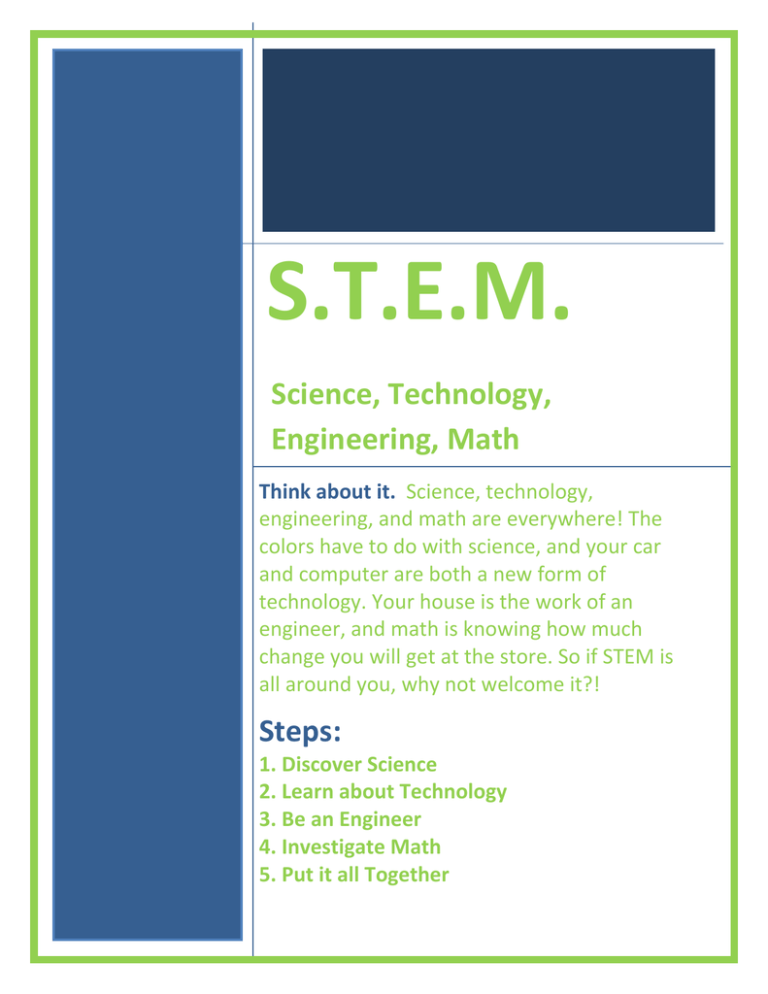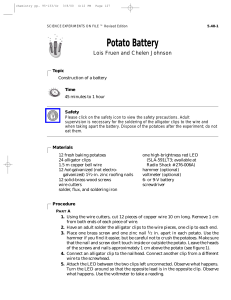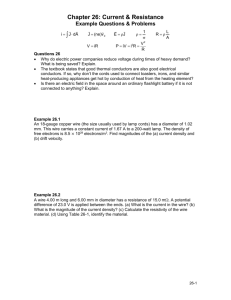this patch today!
advertisement

S.T.E.M. Science, Technology, Engineering, Math Think about it. Science, technology, engineering, and math are everywhere! The colors have to do with science, and your car and computer are both a new form of technology. Your house is the work of an engineer, and math is knowing how much change you will get at the store. So if STEM is all around you, why not welcome it?! Steps: 1. Discover Science 2. Learn about Technology 3. Be an Engineer 4. Investigate Math 5. Put it all Together It is important for girls to know their impact in STEM fields. Women with STEM jobs make 33% more than women in any other kinds of jobs. Young girls have figured out things that top scientists haven't found yet. So do not give up, and remember, failure is impossible. ~~~~~~~~~~~~~~~~~~~~~~~~~~~~~~~~~~~~ 1 Step -­‐ Discover Science Choices – do one: Observe how water flows through the veins of plants. Cut a few white flowers and stick them in a vase of colored water, or take some celery and do the same. What happens to the veins of the celery/flower petals? (The flowers may take a few days to react.) Observe how certain chemicals react to fat. Put some whole milk or half and half in an aluminum pie tin and scatter some drops of food coloring over it. Do not stir in the dye. Then take a Q-­‐Tip with a little bit of soap on the end and touch it to the center of the milk. What reaction does the soap have on the milk? Observe how air moves. Tape a tissue inside a clear plastic cup. Then turn it upside down and dunk it straight down into a tub of water. Without taking your hand off, pull out the cup. What happened to the tissue? Did it get wet, or did it remain dry? Now, dunk the cup again. This time, tilt it slightly before taking it out. What happened when you tilted the cup? Why do you think that happened? Bonus: Extract DNA (deoxyribo nucleic acid) from a banana. Using a knife, cut a banana into tiny pieces to expose more of the cells. Place your banana pieces in a blender, add a teaspoon of salt and slightly cover the mixture with warm water. The salt will help the DNA stay together during the mashing process. Mix in the blender for 5 to 10 seconds making sure the mixture is not too runny. Pour the mixture into the glass jar through the strainer. You want the jar to be about half full. Add about 2 teaspoons of liquid soap and gently stir the mixture. You should try not to create bubbles when stirring. The soap helps to break-­‐down cell membranes to release the DNA. Carefully pour very cold rubbing alcohol down the side of the glass stopping near the top. When pouring the alcohol, make sure that two separate layers are being formed (The bottom layer being the banana mixture and the top layer being the alcohol). Wait for 5 minutes to allow the DNA to separate from the solution. Use the toothpicks to extract the DNA that floats to the surface. It will be long and stringy. When extracting the DNA, twist the toothpick slowly. Be sure to only remove the DNA from the top layer. You can also try repeating this experiment again using other foods such as an onion or chicken liver. 2 Step -­‐ Learn about Technology Choices – do one: Build an electromagnet. You will need at least 18 inches of insulated copper wire with about an inch of insulation stripped from each end, a nail, some paperclips, and a 9 volt battery. (If wire is not insulated, be careful, it may get hot). Repeatedly wrap the wire around the nail, leaving at least three inches hanging off at each end. Wrap each end of the wire around one of the battery’s terminals. Practice using your magnet to pick up the paperclips. Build a potato circuit. You will need two potatoes, two short pieces of heavy copper wire, two common galvanized nails, three alligator clip/wire units (alligator clips connected to each other with a wire), and one simple, low-­‐voltage LED clock that functions from a 1-­‐ to 2-­‐ volt button-­‐type battery. Remove the battery from the battery compartment of the clock. Make a note of which way around the positive (+) and a negative (-­‐) points of the battery went. Number the potatoes as one and two, and insert one nail in each potato. Put one short piece of the copper wire into each potato as far away from the nail as possible. Use one alligator clip to connect the copper wire in potato number one to the positive (+) terminal in the clock's battery compartment. Use another alligator clip to connect the nail in potato number two to the negative (-­‐) terminal in the clock's battery compartment. Use the third alligator clip to connect the nail in potato one to the copper wire in potato two and set the clock! Get acquainted with your computer. Explore 3 computer programs like Paint (found in Accessories), Chrome or Internet Explorer, or a word processing program like Microsoft Word. For more fun, compare programs that have the same or similar purposes. For example, you could compare Google Chrome with Firefox, or Microsoft Word with Microsoft Excel. You could also compare different e-­‐mail or social networking sites. Bonus: Choose an aspect of technology (i.e., telephone, car, computer, video games) and talk to a person one or two generations older than you, and note their experiences with that technology. Based on what you learn, how do you think technology will affect the future? 3 Step -­‐ Be an Engineer Choices – do one: Play around with gravity. Build a mini slide out paper towels and toilet paper tubes, then roll marbles or little things down the slide. See how different ways you put the tubes affect where the ball goes or how fast it goes! Learn about stability. Take two strips of construction paper two inches by six inches and a pair of scissors. Fold or cut the paper in different ways that you think will be able to hold weight. Do not use tape or glue! After you are satisfied with your fold, stack books on it. See how long your paper can keep the weight elevated off the surface. Learn about bases. Get one sheet of construction paper, one foot of masking tape and a paper clip. You may need scissors to do this project. Try to build the tallest structure from the materials given. A big base is the key to success. Bonus: Play around with Legos. Build three structures with different bases, bodies, and styles. What is the same/different about them? Which one is sturdiest? What techniques did you use? Bonus: Look around at buildings and bridges. Do you notice different angles and shapes in the structure? 4 Step -­‐ Investigate Math Choices – do one: Complete one (or two) Sudoku. (Daisies, try an easy one; Brownies, give an intermediate one a go; and Juniors, attempt a harder one). A Sudoku is a puzzle with 9 rows of 9 squares, 9 columns of 9 squares, and 9 boxes with 9 squares in each. (Some Sudoku have fewer or more squares in each column, row, etc., but the same rules apply). Some boxes have numbers, some do not. The idea is to have the numbers 1-­‐9 (in no particular order) in each row, column, and box without any repeating. For more fun do the next level up or one level down and compare them! Improve your money-­‐handling skills by setting up and operating a store. • Daisies, try to figure out how much money you have received for a purchase and the change due. If you need to, have someone help you out. • Brownies, count your money and make a purchase or two that requires you to make change. • Juniors, select your merchandise and receive a percentage off. Figure out how much money it costs. Write out the original cost then the percent off, how much you paid, and what items you bought. This will give you a receipt. Learn about measurement. • Daisies, use a ruler to measure the given square object. Figure out whether you used inches or centimeters. • Brownies, measure all the sides of a rectangular object. Add them up to get a perimeter. • Juniors, measure the diameter of a circle, or a line that goes right down the middle of the circle. Then multiply the diameter by 3.14 or pi ( ). This will give you the circumference, or distance around the circle. Bonus: Using the chart below, how much does your first name equal? How about your last name or your middle name? You can also experiment with other words and phrases. a b c d e f g h i j k l m 1 2 3 4 5 6 7 8 9 10 11 12 13 n o p q r s t u v w x y Z 14 15 16 17 18 19 20 21 22 23 24 25 26 (For more letter/number combinations and mathematical phenomena, go to -­‐ http://www.youtube.com/watch_popup?v=h60r2HPsiuM &feature=youtube_gdata_player 5 Step -­‐ Put it all Together Choices – do one: Talk to someone you know. Chat about how science, technology, engineering, and math have to do with each other and how they are the same/different. Write a paragraph or two. Write about how science, technology, engineering, and math are similar/different and how they have to do with each other. Draw up a circle chart (see example below). Explain how science, technology, engineering, and math have to do with each other and their similarities/differences. (You may need more than one to compare the topics) Ex-­‐ Bonus: To learn more about stem go to-­‐ http://www.whitehouse.gov/administration/eop/ostp/wo men (this one is more for juniors or adults) http://www.youtube.com/watch?v=o9GvnmzxEwA&nored irect=1 (also more for older kids) http://www.youtube.com/watch?v=Q_11rwb4vEc (Great video, shows some amazing science projects) http://gemsclub.org/yahoo_site_admin/assets/docs/GEM STOOLKIT.1450638.pdf (more for adults)



